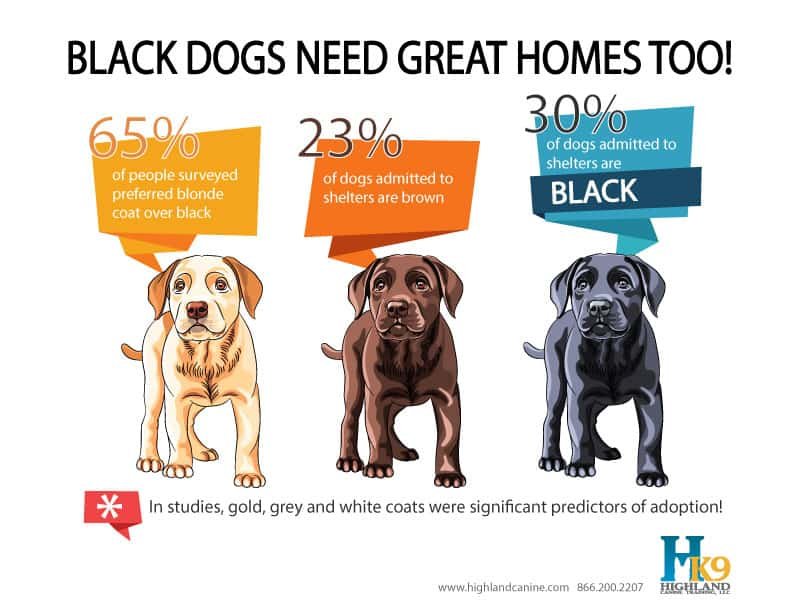Table of Contents
Have you ever heard of “Black Dog Syndrome”? It’s a theory that suggests that big, black dogs are less likely to be adopted from animal shelters compared to smaller, lighter-colored dogs. Despite there being no behavioral differences between black dogs and dogs of other colors, black dogs tend to spend more time in shelters and are euthanized more frequently. While there is conflicting data on whether Black Dog Syndrome actually exists, various studies have been conducted to understand why potential adoptees may shy away from black dogs. Factors such as poor visibility in shelters, negative portrayals in media, and subconscious association of the color black with misfortune or evil have been explored. However, there are also studies that contradict the theory, showing that black dogs have comparable adoption rates to dogs of other colors. The issue of Black Dog Syndrome remains a topic of debate and discussion.

What is ‘Black Dog Syndrome’?
Black Dog Syndrome refers to the phenomenon in which black dogs are less likely to be adopted from animal shelters compared to lighter-colored dogs. This theory suggests that black dogs spend more time in shelters and are euthanized more frequently, despite having no inherent behavioral traits that make them more dangerous or aggressive. Several factors contribute to Black Dog Syndrome, and numerous studies have been conducted to determine the prevalence and impact of this phenomenon in shelters.
The theory behind Black Dog Syndrome
The theory of Black Dog Syndrome originated from various research findings and observations. One aspect of this theory suggests that black dogs do not photograph as well as lighter-colored dogs, making it more difficult for potential adopters to envision them as family pets. Additionally, black dogs may be less visible in animal shelters, making them easily overlooked by potential adoptees during shelter tours. Negative portrayals of black dogs in film and media have also played a role in perpetuating this theory. Some individuals may subconsciously associate the color black with misfortune or evil, leading them to avoid adopting black dogs.

The prevalence and impact of Black Dog Syndrome in shelters
Research has shown that black dogs are indeed at a disadvantage when it comes to adoption rates in shelters. A 1998 study published in the Journal of the American Veterinary Medical Association found that dogs with black coats were at a greater risk of euthanasia, while dogs with gold, white, and gray coats were more likely to be adopted. Similarly, a 2002 study conducted in California by the Journal of Applied Animal Welfare revealed that pure-black colors were negative factors in adoption rates. A 2013 study presented at the International Society of Anthrozoology conference in Chicago found that black dogs were more likely to be judged as unfriendly and aggressive, further highlighting the impact of Black Dog Syndrome in shelters.
Factors that contribute to Black Dog Syndrome
Various factors contribute to the existence of Black Dog Syndrome in shelters. One significant aspect is the way black dogs are portrayed in media, including films and television shows. There is often a stereotype associated with black dogs, depicting them as aggressive or dangerous, which can influence potential adopters’ perceptions. Additionally, the color black has historically been associated with misfortune or evil in some cultural beliefs, leading to a subconscious bias against black dogs. These societal factors, combined with the difficulties in photographing and visibly showcasing black dogs in shelters, contribute to the prevalence of Black Dog Syndrome.

Where did the theory of Black Dog Syndrome originate?
The theory of Black Dog Syndrome originated from various research studies and observations. One aspect of this theory stems from the fact that black dogs do not photograph as well as lighter-colored dogs. This can make it challenging for potential adopters to see their true personalities and characteristics through photographs, reducing their chances of being chosen for adoption. Additionally, black dogs may be less visible in animal shelters, making it easier for them to go unnoticed during shelter tours. This invisibility can result in fewer opportunities for interaction with potential adopters, leading to lower adoption rates for black dogs. Finally, the negative portrayal of black dogs in film and media has contributed to the perpetuation of Black Dog Syndrome.
Research on black dogs not photographing well
Research has shown that black dogs tend to be more challenging to photograph effectively compared to lighter-colored dogs. The contrast between their dark coats and the surrounding background can make it difficult to capture their features, making them appear unappealing in photographs. Potential adopters often rely on photographs to get a sense of a dog’s personality and appearance before visiting a shelter. If black dogs do not photograph well, it can decrease their chances of attracting potential adopters’ attention.

Research on black dogs being less visible in shelters
Another aspect of Black Dog Syndrome is that black dogs may be less visible in shelters, especially in dimly lit or overcrowded environments. The dark color of their coats can make them blend in with their surroundings, making them less noticeable to potential adopters. This lack of visibility can result in black dogs receiving fewer interactions and less interest from potential adopters during shelter tours. As a result, they may spend more time in shelters and have lower chances of being adopted.
Negative portrayal of black dogs in media
Black dogs have often been portrayed in a negative light in films and other media, perpetuating stereotypes and misconceptions. These negative portrayals can influence potential adopters’ perceptions and create biases against black dogs. For example, black dogs are often portrayed as aggressive, dangerous, or associated with supernatural entities, reinforcing the idea that they are less desirable as family pets. This negative media representation contributes to Black Dog Syndrome by shaping public attitudes towards black dogs.

Associating the color black with misfortune or evil
The color black has long been associated with misfortune or evil in various cultural beliefs and superstitions. This association can subconsciously influence potential adopters’ decision-making when choosing a dog from a shelter. The perception that black dogs bring bad luck or are somehow less favorable than lighter-colored dogs can impact the adoption rates of black dogs. These deep-rooted associations with the color black contribute to the existence of Black Dog Syndrome.
Which studies support the idea that Black Dog Syndrome exists?
Several studies have provided evidence supporting the existence of Black Dog Syndrome. In a 1998 study published in the Journal of the American Veterinary Medical Association, it was found that dogs with black coats were at a higher risk of euthanasia, while dogs with gold, white, and gray coats were more likely to be adopted. A 2002 study by the Journal of Applied Animal Welfare, focusing on adoption centers in California, also revealed that pure-black colors were negative factors in adoption rates. Additionally, a 2013 study presented at the International Society of Anthrozoology conference in Chicago found that black dogs were more likely to be judged as unfriendly and aggressive, further supporting the prevalence of Black Dog Syndrome.
Are there other studies contradicting the theory of Black Dog Syndrome?
While some studies support the idea of Black Dog Syndrome, there is also research that contradicts this theory. A 2015 study published in Animal Welfare investigated two dog shelters in the Pacific Northwest over a four-year period. The study found that black dogs had comparable adoption rates to dogs of other colors in both shelters. Another study conducted in 2013 at two New York animal shelters found that coat color had no significant effect on the length of time spent at the adoption center. These contrasting findings suggest that the existence of Black Dog Syndrome is not universally supported and may vary depending on the specific context or location.
What about black cat syndrome?
Similar to Black Dog Syndrome, there is evidence suggesting that black cats also face slower adoption rates compared to their lighter-colored counterparts. A 2015 research study examined the effects of coat color on adoption rates using data from Petfinder. The study found that cats with predominantly black coats received substantially fewer clicks per day on the website, indicating reduced interest from potential adopters. This phenomenon, known as black cat syndrome, highlights the existence of color biases in the adoption process for cats as well.
Conflicting evidence and opinions on Black Dog Syndrome
The existence of Black Dog Syndrome is a topic of debate within the animal welfare community. While some studies indicate its prevalence and impact, there is conflicting evidence and varying opinions on this issue. The conflicting studies mentioned earlier suggest that external factors may influence the adoption rates of black dogs differently depending on the specific circumstances or locations. Targeted campaigns have been launched to encourage the adoption of black dogs, aiming to raise awareness about the potential biases associated with coat color. Reader feedback and personal experiences play a role in shaping the ongoing discussion surrounding Black Dog Syndrome.
Discussion of conflicting studies
The conflicting studies on Black Dog Syndrome highlight the complexity of this issue. While some studies demonstrate that black dogs have lower adoption rates, others suggest comparable adoption rates between black dogs and dogs of other colors. These varying findings may be attributed to different methodologies, sample sizes, or shelter environments. It is important to consider the context in which these studies were conducted and take into account the specific factors that may influence adoption rates.
Targeted campaigns to encourage adoption of black dogs
Recognizing the challenges faced by black dogs in shelters, targeted campaigns have been launched to address Black Dog Syndrome. These campaigns aim to raise awareness about the biases associated with coat color and promote the adoption of black dogs. By highlighting the positive qualities of black dogs and challenging misconceptions, these campaigns hope to increase their chances of finding loving homes. Education and advocacy play significant roles in combating Black Dog Syndrome and creating more equal opportunities for all dogs in need of adoption.
Reader feedback and experiences
Reader feedback and personal experiences are valuable in furthering the discussion on Black Dog Syndrome. Individuals who have worked in animal shelters or have owned black dogs may have firsthand knowledge of this phenomenon. Hearing from those who have witnessed or experienced Black Dog Syndrome can provide additional insights and perspectives. It is essential to encourage an open dialogue to understand the impact of Black Dog Syndrome on both shelter animals and potential adopters.
Conclusion
In conclusion, Black Dog Syndrome refers to the phenomenon in which black dogs have lower adoption rates compared to lighter-colored dogs. This theory has been supported by various studies highlighting the impact of coat color biases in animal shelters. However, conflicting evidence and differing opinions exist regarding the existence and prevalence of Black Dog Syndrome. Factors such as photographing challenges, visibility in shelters, negative media portrayals, and associations with the color black contribute to this phenomenon. Targeted campaigns and ongoing discussions aim to address Black Dog Syndrome and promote the adoption of black dogs. By challenging biases and raising awareness, we can work towards a more equitable adoption process for all dogs, regardless of their coat color.



